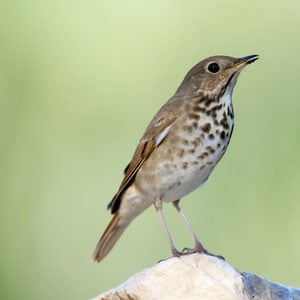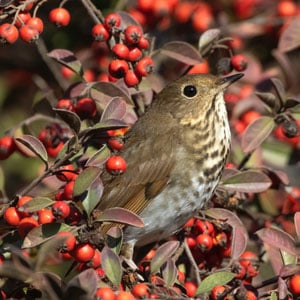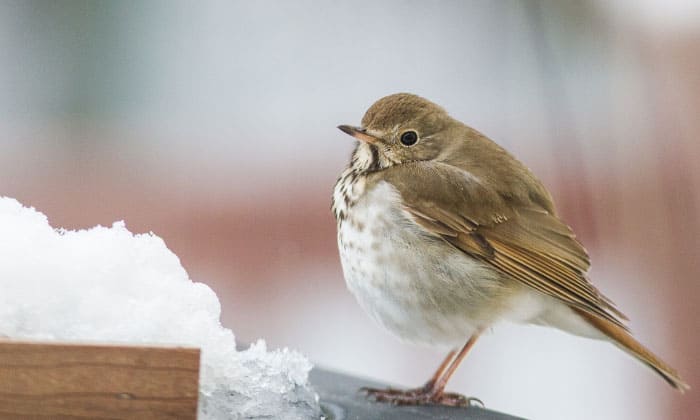All 50 states in the USA have a chosen state bird. They are usually selected because they are unique to the region, are commonly found there, or represent the state in some symbolic way.
What is the state bird of Vermont? Since June 1941, Vermont’s state bird has been the hermit thrush (Catharus guttatus). The bird can be found all over wooded areas in the Green Mountain State, but only during the summer.
Reportedly, it was recommended as the state bird by the Federated Women’s Club. It was later on chosen over other options for its sweet-sounding song.
Table of Contents
The State Bird Of Vermont – The Hermit Thrush
| Size | Length: 5.9 to 7.1 inches (15 to 18 cm) Wing span: 9.8 to 11.8 in (25 to 30 cm) Weight: 0.63 to 1.31 oz (18 to 37 g) |
| Color | Cream and brown with a spotted breast and a reddish tail |
| Habitat | Near open areas in forests and heavily wooded areas.
The species lives in Vermont during the summertime but migrates south during the winter months. |
| Diet | During the spring: Insect-eaters, including bees, wasps, flies, and caterpillars. They may also eat small lizards and amphibians.
During the winter: Fruit and berries. |
| Mating Period | Mid-May to Mid-August |
1. Appearance
The Vermont hermit thrush is a relatively small bird, nesting in between sparrows and robins, size-wise. They are a mix of cream and brown with signature spotted breasts.
However, for those interested in birds of Vermont identification, their reddish tail sets hermit thrushes apart from others in their family.
2. Habitat
As its name suggests, the bird tends to remain in hiding more than out in the open. The hermit thrush habitat is typically dense forest thickets and brush. They are also often described as being heard before being seen.
The species can be found across North America and are one of the most plentiful birds in VT in the summer. When the cold months arrive, though, they migrate south, where the weather is more bearable.
3. Diet and Foraging Behavior
Hermit thrushes are omnivores, meaning they eat both plant- and animal-based food. However, the wood thrush diet does not stay the same throughout the year. In fact, it changes depending on the season.
In the springtime, their diet is primarily made up of insects, including bees, wasps, flies, and caterpillars. They even eat the occasional lizard, salamander, or small amphibian.
In the winter, hermit thrushes switch to berries, fruit, and whatever else they can scavenge.
Hermit thrushes are often seen near the forest floor, pecking and foraging for food. They hop, skip, bob its tail, and flick their wings while foraging.
4. Song and Sounds
The hermit thrush is known for its beautiful singing. The species has gained the title of “American Nightingale,” with a signature “melancholic” song. Writers have also described the hermit thrush’s singing as “wild and ethereal.”
Aside from their singing, the hermit thrush is known for its many sounds and calls, including low chups while foraging, shrill rheee alarm calls, mewling sounds similar to kittens, and chirpy pweet pweet calls between two adults.
5. Breeding and Family Life
Hermit thrushes typically breed between mid-May to mid-August. During their mating season, hermit thrushes can produce a clutch size of 3-6 eggs. While they commonly produce just one brood per season, the birds may sometimes lay a second or even third brood as well.
Males return to Vermont first sometime in April and begin staking out its territory. Once the females arrive, he initially ignores them or even aggressively chases them in circles during this period.
However, once he has chosen a mate, he settles down to begin mating.
The female thrush bird typically takes the lead in constructing the nest. After that, once the eggs have been laid and hatched, the female stays to tend to the chicks while the male brings a steady supply of food back to his family.
6. Hermit Thrush Subspecies
There are three general groups of hermit thrushes:
- A Pacific coastal group that is small and brown with thin bills and gray-tinted flanks.
- A group from the western mountains that are large and grayish. Their bills are relatively thin, but not as much as the Pacific coastal group.
- The eastern group that is more brownish-reddish, and to which the Vermont group belongs. They are bigger than the ones in the Pacific coastal group but smaller than their counterparts from the western mountains. Their bills are the thickest among the three types.
Aside from appearances, an interesting difference is that eastern hermit thrushes tend to nest on the ground, while those in the west tend to nest in trees.
Frequently Asked Questions
Why is the hermit thrush the state bird for Vermont?
Among the small birds of Vermont, legislators had to choose between the crow, blue jay, and hermit thrush to become Vermont’s official state bird.
In the end, the hermit thrush won because, as its supporters argued, they were all born and raised in Vermont before migrating south for the winter. Therefore, they are all considered “native Vermonters.”
The small brown bird Vermont also won because of its distinctive sweet yet melancholic call.
When did the hermit thrush become Vermont’s state bird?
The hermit thrush officially became Vermont’s state bird on June 1, 1941. It is the only state that has claimed this species as its own.
Conclusion
Looking at pictures of Vermont birds, the hermit thrush does not seem to stand out. It is a small, brown, unassuming spotted bird.
Despite that, it can stand tall when people ask what is the state bird of Vermont. Because it was chosen among all other possible bird species that live in the state.
If you are hoping to spot one yourself, stay close to forest openings and along trails. Keep your ears open in the spring and summer and simply follow its song. In the winter, check berry bushes.
Good luck, and happy bird listening and watching!
Related:
- The state bird of Texas
- Fun facts about the state bird of New York
- Interesting facts about the California quail bird
Furthermore, click here to discover the state bird map!

George and I became friends after a birdwatching trip with our new group. And we have been enjoying every adventure together. When he told me the idea of establishing a site that shares our experiences and fun, I immediately agreed. After trials and errors, here we have Thayerbirding.



















